

International League of Conservation Photographers. Hugin - Panorama photo stitcher. PTAssembler. Introduction.
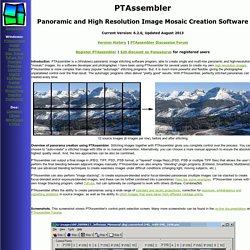
PTAssembler is a (Windows) panoramic image stitching software program, able to create single and multi-row panoramic and high-resolution "mosaic" images. As a software developer and photographer, I have been using PTAssembler for several years to create my own high resolution images. PTAssembler is more complex than many popular "automagic" stitching programs. But, it is much more powerful and flexible, giving the photographer unparalleled control over the final result. The automagic programs often deliver "pretty good" results. 12 source images (6 images per row), before and after stitching Overview of panorama creation using PTAssembler.
PTAssembler can output a final image in JPEG, TIFF, PSD, PSB format, or "layered" image file(s) (PSD, PSB or multiple TIFF files) that allows the user to perform the final blending between adjacent images manually. Screenshots. Photo stitching software 360 degree Panorama image software - PTGui Stitching Software. Manage your photographs as a professional with the power of Open Source. Digital Painting. Creative Freedom. Rawstudio. RawTherapee Blog. The photo workflow software. UFRaw - Home. 1100 Colecciones. - Aula de Especialización Fotográfica.
Hydra for iOS 9 - Amazing Photography — About. Amazing Photos, Beyond Sensor Limits Thanks to innovative capture technology, Hydra lets you take beautiful pictures even in the most difficult lighting conditions.

That makes it a great companion to the built-in Camera app on your iPhone or iPad. How does it work? Hydra merges up to 60 individual images to make a single high-quality picture, effectively getting more light from the scene. That way, Hydra produces up to 32-megapixel high-resolution images (4x the 8-megapixel sensor resolution), enhanced HDR, better 2x/4x zoom, and reduced camera noise in low-light scenes. Hydra relies on the latest evolutions of camera hardware, and uses the latest camera APIs and GPU rendering technologies of latest iOS. More Highlights, More shadows. SKEW on the App Store. Polarr: Smart Photo Editing.
Daniel Box - Blog. StenopeiKa macchine fotografiche artigianaliStenopeiKa. Tu Habitación como Cámara Estenopeica: ¿Quieres Vivir dentro de una Cámara de Fotos? The original DSLR camera simulator. Lighting Lighting is the single biggest determinant of how your camera needs to be set.
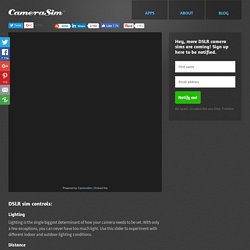
With only a few exceptions, you can never have too much light. Use this slider to experiment with different indoor and outdoor lighting conditions. Distance Use this slider to simulate how close or far you are in relation to the subject. Focal length Moving this slider is the same as zooming in and out with your lens. Mode The exposure modes of an SLR let you control one setting while the camera automatically adjusts the others. ISO refers to how sensitive the “film” will be to the incoming light when the picture is snapped. Aperture Aperture, or f-stop, refers to how big the hole will be for the light to pass through when the shutter is open and the picture is snapped. Shutter speed Shutter speed is how long the shutter needs to be open, allowing light into the camera, to properly expose the image.
Iluminación: Conceptos que debemos tener presentes para medir la luz a la hora de hac. A la hora de fotografiar es muy importante saber iluminar y para poder hacerlo bien es imprescindible que sepamos medir la luz, que conozcamos las diferentes formas de hacerlo y las leyes que se aplican.
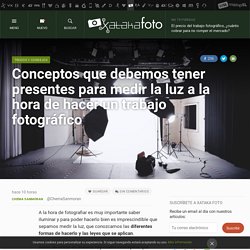
Antes de entrar en materia hay cuatro conceptos que tenemos que tener claros: Calidad, color, dirección e intensidad. Hace unos meses Juan Carlos López nos los explicaba en este artículo. Photoskop: Interactive Photography Courses and Lessons. Exposure Awards 2017. Get a free Submission Review Enter a series or 5+ images in the Exposure Awards 2017 and get a free submission review!

We believe that every photographer who enters deserves thoughtful feedback on their work. That's why we have recruited over 100 of the top photo editors, educators, portfolio reviewers, curators, and other industry professionals to give you constructive feedback on your photography plus recommendations for improving your practice. Enter Competition » Learn more and view actual submission reviews » IMPORTANT DETAILS: Submission reviews will be sent AFTER the Exposure Awards 2017 deadline (it takes time to write a thoughtful review!). I really have to say thank you (BIG TIME!) Christian BobstLensCulture Visual Storytelling 2015 FinalistWorld Press Photo, 2nd place Winner. 67 Portrait Poses (Printable) - Digital Photography School Resources.
These portrait posing guides are VERY handy to have with you on a shoot.
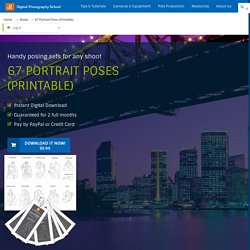
They include 67 poses broken down into 7 different sets. Inspired by our eBook Striking The Pose and professionally illustrated to ensure they are simple and easy to use. When you order you’ll receive two versions: A printable version that’s designed to be printed and folded for quick referenceA digital version that’s designed to be stored on your phone or tablet for screen viewing. 1100 Colecciones. - Aula de Especialización Fotográfica. Gestion de Color, fotografía científica, imagen digital - Jose Pereira. 13 videotutoriales de iluminación fotográfica. Explained lighting schemes. Explained lighting schemes, lighting a face. Fotografía analógica y digital. Técnicamente, la fotografía consiste en captar de forma permamente una imagen, gracias a la luz que reflejan los objetos.
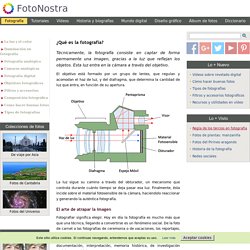
Esta luz entra en la cámara a través del objetivo. El objetivo está formado por un grupo de lentes, que regulan y acomodan el haz de luz, y del diafragma, que determina la cantidad de luz que entra, en función de su apertura. La luz sigue su camino a través del obturador, un mecanismo que controla durante cuánto tiempo se deja pasar esa luz. Finalmente, ésta incide sobre el material fotosensible de la cámara, haciendolo reaccionar y generando la auténtica fotografía.